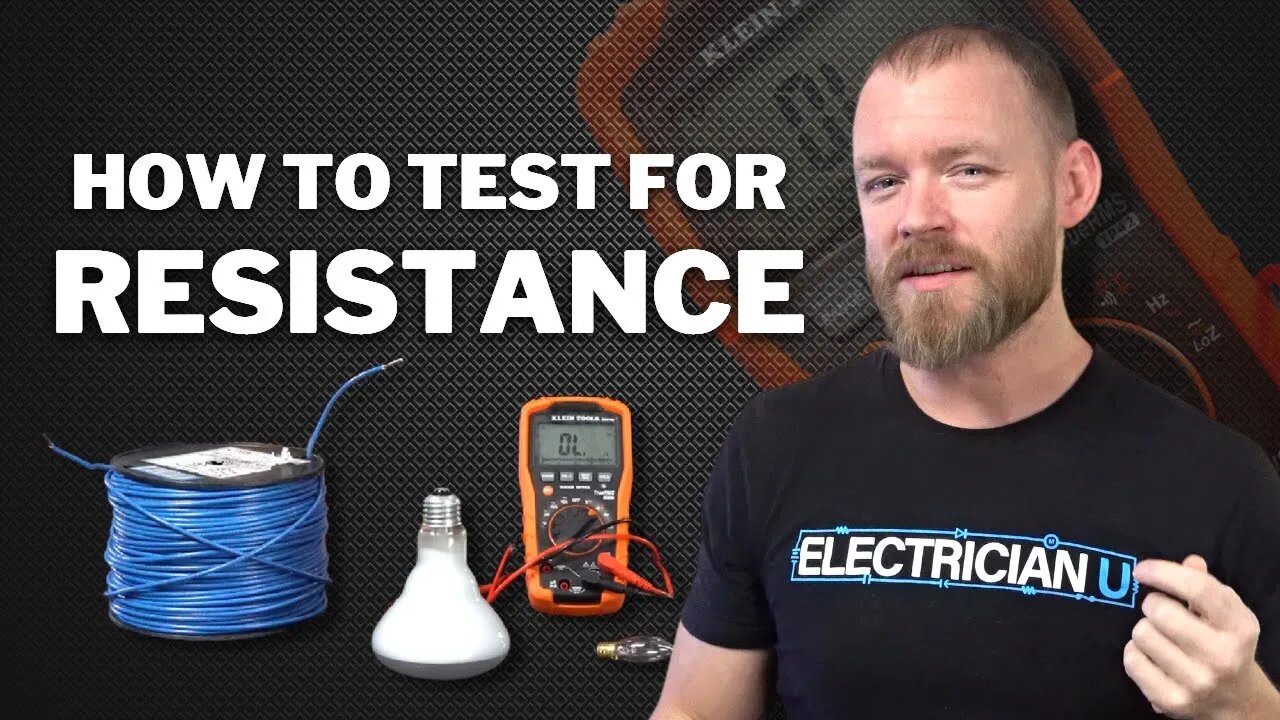Premium Only Content

How to Test for Resistance? What is Continuity?
Join this channel to get access to perks:
https://www.youtube.com/channel/UCB3jUEyCLRbCw7QED0vnXYg/join
Most electricians know how to use our meters to troubleshoot power issues by finding voltage and amperage. But what about using them to find Ohms or Continuity? And what are those values good for? In todays episode of Electrician U, Dustin explains how to use your meter to get these values and what those values could be used for in the field.
🤘⚡️MEMBERSHIP⚡️🤘
JOIN ELECTRICIAN U - become a member and get:
FREE Continuing Education every year
FREE Practice Exams
FREE Monthly Video Courses
FREE Weekly Live Instructor-Led Classes
FREE Monthly Educational Newsletter
Premium Members-Only Content
Private Discord Channel
Monthly Members-Only Discord Chats
Sign up here --- https://www.electricianu.com/electrician-u-membership/
🎧🎹MUSIC AND VIDEO:🎹🎧
https://www.facebook.com/descantmv
🎬✍️ART AND ILLUSTRATION:✍️🎬
https://www.daverussoart.com
First, be aware that different meters will produce different value ranges. Most electricians in the field don’t carry our DMM (digital multi meters) with us everywhere. They are rather large and susceptible to damage, so are usually kept in the truck. Instead, we probably will have our Ampere Meter with us. An amp meter may read in thousandths of ohms whereas a DMM may read exactly what the ohms are. Something to keep in mind. Also, when using your DMM, make sure you are following the instructions for your particular meter and plug the leads in the correct ports on the meter. And finally, when using your DMM OR Amp Meter, do not check for continuity on an energized circuit. Most meters are fused to protect themselves, but checking for continuity or Ohms on an energized circuit will certainly blow that fuse.
Some meters will have the continuity and resistance setting at the same place on the dial. Some are different settings. For continuity, look for the little speaker symbol. For ohms specifically, look for the Ohms symbol (or the Greek letter for Omega) which looks sort of like an inverted horseshoe. To check for either continuity or Ohms on either meter, simply turn the dial to the setting you want and place one lead on one end of the wire (or whatever you are testing) and one on the other. If your meter howls at you, it is sensing that a complete loop has been made. If the meter is on Ohms vs Continuity the meter should display the amount of ohms worth of resistance.
But what are those values good for out in the field? Well, you could use the continuity setting to see if a fuse or filament type lamp (not a CFL) is good. Put one lead on each end and if there is continuity, then the fuse is viable (or the lamp is good). Or maybe you need to run wire to a piece of heating equipment that isn’t labeled as to its amperage. You could test across the heating element to see how much resistance it holds. Then using Ohms law, you can figure out how many amps it will draw and then you can base your wire size upon that. So, for instance if you had a 240 piece of equipment with a heating element of 5.77 ohms, by applying Ohms Law (Amps=Voltage Divided by Resistance) you will see that the equipment will draw 41.6 amps (plus any other items within the equipment like a blower motor).
Another nifty veteran trick (its not really a trick!) to use resistance for is to check wire length. In Chapter 9 Table 8 of the NEC, it lists the specific Ohms for different types of wire. Simply pick the wire type you will be checking (the table has both solid and stranded- solid wire shows a quantity of 1 and stranded has all the others), coated or uncoated and aluminum or copper. The table shows the value per 1000’ of conductor. So say you have a roll of #12 wire in the shop and you need about 250’ for a run you are pulling. Simply put one lead on one end of the rolled-up wire and the other lead on the opposite end of the wire. 1000’ of #12 should be about 2 ohms worth of resistance. So an entire 500’ roll of #12 should read about 1 ohm and half a roll about .5 ohms. Super useful. You can also pull the same prank on wires that are installed. If you had a 120v pole light installed and needed to know the length of the run, with the POWER OFF, tie 2 of the 3 conductors together (say the hot and the neutral) at the pole, disconnect the wires from the breaker/bus bars and take an Ohms reading. Divide the value it gives you by 2 (since you used 2 wires) and bam, you have a length of wire!
We hope this has been helpful in understanding how to take Ohms/continuity readings with your meter and what they could be used for! Is there a topic you would like to see discussed on Electrician U? Leave a comment in the comments section and let us know. Please continue to follow Dustin and Electrician U as we are constantly updating our content to assist our followers in becoming the best electricians that they can be.
#electrician #electrical #electricity #how #to #test #for #resistance #continuity
-
 0:57
0:57
Electrician U
1 year agoMy FAVORITE Tester for Electricians - What Hand Tools Are YOU Missing
5.79K -
 LIVE
LIVE
Alex Zedra
32 minutes agoLIVE! Spooky Games tn
114 watching -
 1:39:58
1:39:58
Glenn Greenwald
3 hours agoWhy Did Zohran Win & What Does it Mean? Plus: Dick Cheney, "Hero of the Resistance" | SYSTEM UPDATE #543
98.3K45 -
 LIVE
LIVE
SilverFox
4 hours ago🔴LIVE - Arc Raiders is Game of the Year
133 watching -
 1:44:39
1:44:39
vivafrei
3 hours agoArctic Frost is Bigger Scandal than you Think!! Live with Former Green Beret Ivan Raiklin!
21.1K22 -
 LIVE
LIVE
Turning Point USA
2 hours agoTPUSA Presents This Is the Turning Point Tour LIVE with Eric and Lara Trump at Auburn University!
1,621 watching -
 LIVE
LIVE
XDDX_HiTower
1 hour agoBATTLEFIELD 6 REDSEC! [RGMT CONTENT Mgr.
34 watching -
 LIVE
LIVE
Joker Effect
39 minutes agoSTREAMER NEWS: What actually occurred at Dreamhack ATL. Frontier Airlines. Kick Staff Trolled me?!
462 watching -
 LIVE
LIVE
VapinGamers
50 minutes agoBF6 RedSpec - Nothing but Wins and New Rum Bot Testing - !rumbot !music
13 watching -
 1:01:50
1:01:50
MattMorseTV
3 hours ago $0.01 earned🔴Now he’s literally BEGGING for a DEAL. 🔴
23K37